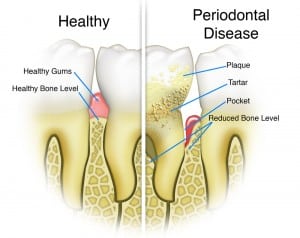At your last dental appointment, you may have noticed your dentist reading out or making notes of numbers as they checked your gums. Why do dentists do this? And what do the numbers mean when dentists check your gums? Your dentist is checking for gum disease. So how does this work? Let’s take a closer look at this process, called periodontal charting.
First, What is Gum Disease?
You’re probably aware that your teeth can be damaged by cavities—small holes in your teeth created by plaque and bacteria. However, your teeth aren’t the only things in your mouth that can be damaged by bacteria. Your gums can also be affected.
While most of us tend to focus on our teeth when we brush and floss, our gums also play an essential role in our overall dental health. Your gums help to protect your teeth roots and keep your teeth secure and stable. So what happens when bacteria start to damage our gums?
When your dentist inspects your gums and reads out numbers, they’re checking for gum disease. A good understanding of gum disease will help to explain this process.

Gingivitis
“Gums” is the common name for the gingiva, the soft, pinkish tissue surrounding the base of teeth. When the gingiva become inflamed or infected, this condition is called gingivitis. When this happens, the gums begin to pull away from the teeth. They will also appear darker in color and look puffier than normal. The most common sign of gingivitis is bleeding gums when you floss. This doesn’t mean that flossing is bad for you—it’s a sign that your gums are sensitive from exposure to plaque. If you continue flossing and brushing for several days, this bleeding should stop.
This is the first stage of gum disease, and this is reversible with relatively simple procedures.
Periodontal Disease
Periodontal disease refers to an infection or inflammation of the periodontium, the deeper tissue within the gums that keeps teeth protected and anchored in place. Periodontal disease is similar to gingivitis, but the problems are deeper and more severe. You may notice that your gums are much darker in color, swollen, and much more sensitive. When periodontal disease is present, the gums have pulled away from the teeth significantly, exposing a bit of the dentin underneath.
Periodontal disease is reversible with the right treatment, like scaling and root planing (SRP).
What Do the Numbers Mean When Dentists Check Your Gums?
Now that you know what gum disease is, how do dentists check for it? What do the numbers mean when dentists check your gums? And how do these numbers show gum disease?
The Dental Sulcus
As previously mentioned, one of the signs of gingivitis and periodontitis is the gums pulling away from the teeth. To determine whether gums are healthy or not, or to determine how severe gum disease is, it’s important to measure how far the gums have pulled away. To do this, dentists assess the dental sulcus.
The dental sulcus is a small groove where the gums meet the teeth. This small space provides an easy way to measure the health of the gums. A healthy dental sulcus is about 0.5 to 2.0 mm wide. If the sulcus is larger than this, it means the gums have started to pull away from the teeth.
Reading the Numbers
To measure the sulcus, dentists use a small probe with millimeter measurements. The dentist uses the probe to measure the sulcus throughout the mouth. This process is called periodontal charting, or perio charting for short. In addition to measuring the health of the gums, perio charting can also measure bone loss in the jaw and other issues deeper under the gums.
In some areas, the sulcus might be within the normal range, and the gums may be healthy. Other areas which might be more difficult to brush or floss may show signs of gingivitis or more signs of periodontal disease. This is why it’s important to check the sulcus grooves all across the gums.
Areas with 2.0 mm or more depth may be affected by gum disease. Dentists write these numbers down so they can monitor the condition of gums from visit to visit.
If your gums appear puffy, darker red or they bleed when you floss, it’s a sign of gum disease. Bacteria are likely hiding in the places that your toothbrush can’t reach, like in between your teeth and in the dental sulcus. Start flossing gently, and make this a habit. You might put your floss on your bed stand so you remember to floss before you go to sleep, or on your desk, so you floss after lunch. Take good care of your gums and you’ll also be taking better care of your teeth.
